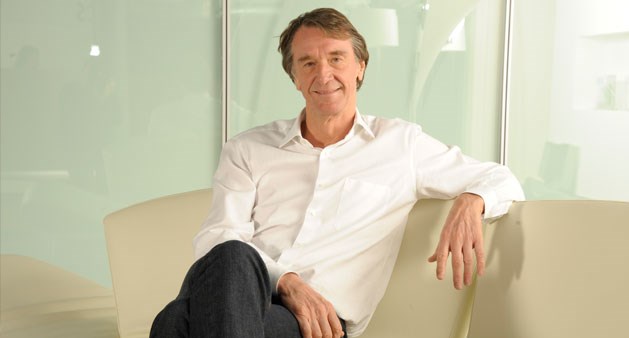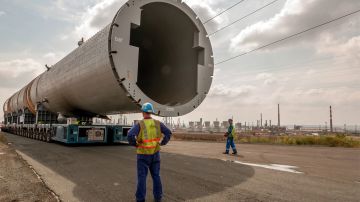INEOS continues to grow and to develop. It came out of the downturn stronger, its businesses are growing organically and it is forming strategic joint ventures in new and emerging markets. The company that was said to have “slingshot out of the recession” has undoubtedly performed well through 2010 and the first half of 2011 but now faces difficult markets towards the end of the year.
In this interview, Tom Crotty, Group Director for Corporate Affairs and Communications talks frankly to Jim Ratcliffe about his priorities for INEOS, the issues facing the company and how he sees its future.
TC: How can it be that despite being one of the world’s leading chemical companies and number 318 in the Fortune 500, INEOS is still frequently referred to as the biggest company the world has never heard of?
JR: I suppose the reason nobody has ever heard of INEOS is simply that we don’t have any consumer products, so we don’t touch the man in the street as obviously all the well known companies such as the Coca Cola’s of this world or companies that are similar in a way to an INEOS such as BP or Exxon, which have their retail petrol stations. We did come out of the shadows when we acquired BP chemicals, which was a large transaction and inevitably because of our size we have become well known. So I think it is beholden on us to work a little bit on our image. It is something that we didn’t have time for before because we were always focused on our business. For the likes of politicians and graduate recruits it is quite important really that people probably know the INEOS name a little more than they do at the moment.
TC: So our revenues fell sharply in the downturn of 2008/2009 but we came through well how do you see INEOS today?
JR: Well we obviously saw our revenue and profitability drop substantially during the crisis but then pretty much everyone in manufacturing did. We came out of that quite well as you say. We made changes and we reduced costs and I think that we came out of it better than many companies, certainly in our industry. Many people did not survive that downturn. The worst, certainly that we have seen in our working lifetimes. Today the company is in much, much better shape; debt has come down, trading in the first half of this year has been extremely good and it was pretty good last year. So I think we are looking quite positively to the long-term future.
TC: We have come out of the downturn of 2008/2009 but just as we are getting back on our feet there is another financial crisis. So what do you think this holds for INEOS?
JR: It is difficult to look into the future. I don’t think we will see a 2008 again. I think the view we have held now for a couple of years is that we will see steady improvement following the 2008/2009 crisis but it wont be a straight line. There will be the odd wobble along the way and I think that this is one of the bigger wobbles but I don’t think it will be the same as a 2008/2009. I think that we are in better shape to handle the bottom of the cycle. Chemicals are always going to be cyclical. Really in a way it is fruitless to predict when the world will be up and when the world will be down. If we could do that there are easier ways of making a living! I think that we just need to make sure that we are in good shape at the bottom of the cycle and I believe we are in pretty good shape.
TC: Now the company grew very quickly through acquisition, but we are now in a very different world with much less credit available. How will this change our business model going forward?
JR: Well it has undoubtedly changed the business model because the credit is less available in the western world. But the other change we are seeing in the world is that much of the economic strength is moving from the West to the East. So you will see INEOS looking much more in the direction of the East. Where we have enormous trade deficits in the West, the East has enormous trade surpluses and some of that trade surplus finds its way into the banking system and becomes available as credit so I think you will see INEOS looking Eastwards, to a number of different projects.
TC: So we now have JVs with PetroChina, with Styrolution and potentially with Sinopec. Do you think we would now look to move into the Middle East and would Joint Ventures work there?
JR: If you are going to these parts of the world, which are very different to our experience base, then you need a partner. If you don’t, you finish up in trouble because the learning curve is quite steep and can be very long. I think it is appropriate for us to have partners in a place like China. We have looked many times at the Middle East. If we ever did choose to proceed there I am sure that we would have a partner but the thing to bear in mind is that there are no end markets there. The desert is not an obvious place to make chemicals. It is quite a difficult environment. And you then have to ship the end products out. So there have to be good reasons to start investing capital in the Middle East and that really means access to very competitive raw materials. That’s really the foundations of development in the region and of course it is not as easy as you think to access those cheap raw materials. Most of our work in the region has been developing relationships and identifying secure sources of raw materials.
TC: The Company is working on an opportunity to make Bioethanol from Waste. How big an opportunity is that for INEOS?
JR: That is the most exciting opportunity in INEOS at the moment, certainly our most exciting new project. Key to that particular technology is that it is extremely flexible. It will take pretty much any type of organic waste and it will convert it into ethanol, a fuel, and export some electricity to the grid. That is quite exciting. Firstly, there is a lot of organic waste around in the world. If you take, for example, the sugar cane industry, they produce sugar from sugar cane but two thirds of the waste is the rubbish that is left over. That rubbish can be turned into a fuel. There is obviously a lot of household waste in the world, there is a lot of construction or forestry waste and so on. Secondly the world has a problem with fuel, as oil becomes more expensive, as it becomes scarce, because it is difficult to get at. The INEOS Bio process solves both issues – turning organic waste into fuel and in addition, will also export some renewable electricity.
We are in the process of building a plant in the States at the moment to the tune of about $150m. This world first plant will come on-stream next year (2012) in Florida and if that is successful, if you were very, very optimistic, you could see these plants being built like Starbucks all over the world converting waste of one kind or another. Waste from small towns in Germany or England for example can be converted into the fuel that could be used in cars. Alternatively, very large facilities could convert the waste of large cities, such as Chicago into huge amounts of fuel or electricity. So it is a very, very exciting project if it turns out to be successful and we should know that in 2012 or 2013.
TC: Looking to the future how do you think INEOS can attract the right calibre of people to continue to grow the company?
JR: Well I think predominantly INEOS is a capital intensive business. We don’t, in reality, have that many people so the people that we have must be extremely well qualified, which typically means that we have a lot of graduates in the organization. We inherited a lot of extremely good people from the various acquisitions that have always been made from bluechip companies but during the process of bedding those companies into INEOS and due to the fact that we have been through the downturn of 2008/2009, we have obviously slimmed down the organization and it was inappropriate during periods such as this to go out recruiting lots of new graduates. As of today it is certainly is very important that we continue the process of recruiting top class graduates for tomorrow. INEOS is an exciting place to work because people get significant levels of responsibility and they can move very quickly through the organization. Even more so because we have not recruited that many graduates over the past ten years.
TC: So how do you see the future for INEOS, where do you see the company in ten years time?
JR: Well I have given up trying to predict the future. It is too difficult, certainly ten years out. It is difficult to predict where INEOS will be, even though I run the company. We have been opportunistic through the last 12 to 13 years. I think the one thing that you can say about the coming years is that, by 2020/2025, in terms of its consumption of Chemicals China will be the same as the rest of the world put together. So it will be like a second planet Earth in terms of chemical demand. If they continue to grow at the current rate there is no question that is where they will be. So they will be as big as Europe plus America combined! If we look at our facilities we have got many Phenol plants we have got Acrylonitrile plants etc but they are all based in America or Europe. We have nothing within China so I think looking ahead, in ten years, I will be surprised if we don’t have a presence and a reasonable footprint in China. It seems sensible to me, if we can find a sensible route into those territories.
TC: So one last question, what is it that actually keeps you awake at night?
JR: Manchester united being thrashed by Manchester City at the end of October. 6 – 1!
But no, seriously the only thing that keeps me awake at night is safety. You can never be complacent. It is number one on the agenda for INEOS and always will be number one on the agenda for INEOS. It is always the first thing we talk about in board meetings. Safety will always be our highest priority.
















